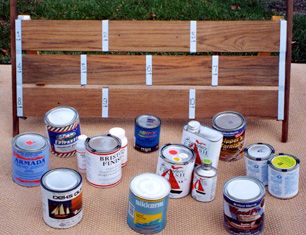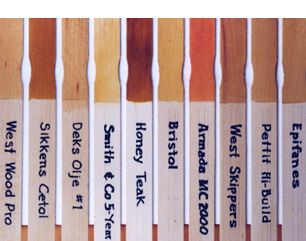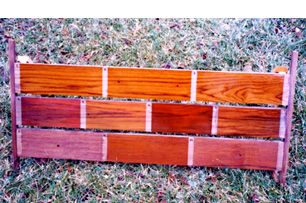Teak is a wondrous wood. Some wood-lovers don’t care for its somber earth-tone colors, preferring instead the luster of mahogany, the richness of cherry, the odor of cedar, the opulence of American black walnut, the flamboyance of rosewood, or the startling beauty of many other tropical woods now available—wenga, bocote, goncalo alves, etc.

Millwrights and professional woodworkers hate teak, whose formal name is tectonis grandis, of the Vervain family (which includes the tea lover’s Lemon Verbana). When cutting tools see teak coming, they scream in terror, “Oh, no!” That’s because teak contains not only oil, but silica. It’s tough stuff. The rough leaves of the teak tree are used as sandpaper.
As a boat wood, teak is peerless. It’s moderately hard, but resists the ravages of the marine environment better than politicians avoid straight answers. As a structural material, teak doesn’t really need any protection from the sun, wind and water. Left alone, the surface turns a strange grey. The grey layer is very thin and can easily be sanded away with 180-grit paper to reveal new-looking teak.
This “weathering” results from sunlight (in particular, the high energy in ultraviolet rays) and water (especially salt water). Some folks like the silver-grey look of teak exposed to the ultraviolet/water torture treatment, however, weathered teak is very difficult to keep clean. Suntan oil, potato chips, and Oreo cookies are often deeply frowned upon aboard teak-decked boats with tyrannical owners.
Keeping weathered teak clean has led to a fair-sized industry purveying oxalic acid, which is very strong stuff. Repeated use of such cleaners results in an undesirably rough surface; the acid actually removes some of teak’s softer fibers, especially if scrubbed against the grain. (Besides the one about never spilling navy beans in the far reaches of the bilge, one of Nature’s immutable laws is: Never scrub raw wood against the grain.)
Most sailors prefer to try to preserve the new look of the teak on either their new boat or the refinished teak into which they’ve poured their hearts, souls, knees and knuckles.
Over the years, Practical Sailor has done many tests of coatings said to protect teak. They fall into four categories: varnish, oil, pigmented stains, and synthetic coatings. We’ll revisit the basics of each coating for a few paragraphs here.
Varnish
We’ve tested dozens of kinds of old-fashioned and new-fangled varnishes, including the water-based varieties, (which so far aren’t really working out too well).
Varnish was greatly improved a few years ago by the addition of ultraviolet light inhibitors. Nobody talks much about these inhibitors, which appear to be mostly micron-ground flakes of aluminum, nickel, or iron oxide. The flakes actually vibrate and make heat as they devour the UV energy. We’re told that most of this UV inhibitor stuff is made by Ciby Geigy, which calls it Tinuvin. They make many varieties and presumably even “designer Tinuvin.” Ciby is a pharmaceutical/chemical Goliath so big ($7.4 billion in 2001) nobody knows where the front door is. The yellowish Tinuvin is expensive ($15-$20 a pound)—and to do the job it has to be about 5% by weight. It was developed primarily for the auto industry, which was looking for a 10-year top coat.
There’s some new, even better organic stuff called HAL, which stands for “hindered amine light stabilizer,” but also can be “hindered phenol light stabilizer,” which would make it HPL, wouldn’t it? It’s supposed to be absolutely colorless, which would be a considerable improvement.
Oils
We’ve tested (and used) various oils for a very long time. Years ago we even experimented with linseed oil as a preservative on a pair of replacement cockpit seats. The warped, discolored mahogany was replaced with teak with a hard oak edge affixed with dowels. Very handsome they were. However, the linseed oil carbonized very nicely and in one summer turned both teak and oak an ugly charcoal color. Still another bit of testimony to that confounded old saying, “We learn by doing.”
The better teak oils are quite simple. They are absorbed into the wood but don’t penetrate very far, unless it’s on the end grain.
The popularity of teak oils may be because they’re easy to apply. They are runny, of course, and if allowed to run through the scuppers, which they will do if flooded on too enthusiastically, they remove the wax from the topsides. If not wiped off immediately, they dry in streaks and require an oily rag to remove.
The other primary characteristics of the teak oils are (1) they look good; and (2) they don’t last long.
Pigmented Stains
About a decade ago, “pigmented stains” appeared on the market.
The makers like to throw around terms like fluoropolymers, quaternaries, cross-links, benzotriazole, “transparent” paint, alkoxylated amines, hindered phenol, cationic and nonionic surfactants, etc. But basically, these “breathable” treatments work by including a color in the liquid. The pigment shields the wood from the sun (but not the water). In effect, they might as well be paint, because they obscure the wood’s natural appearance. However, no one can deny that they protect the wood.
Cetol was the first one on the market. It went forthwith under the PS magnifying glass. And, as more of these products appear, they become part of the testing.
Synthetic Sealers
More recently, the market has been flooded with what are called synthetic coatings, which can have a dozen or more ingredients and call for three or four different manners of application. The manufacturers like to call them “systems.” Various types provide finishes from high gloss to flat, which the makers are wont to call “matte,” which gives it a nice French ring.
For sure, most of these multicoat systems take time and much work. Most makers point out that you must follow their stringent directions.
Basically, what you’re doing is piling up a good thickness of something not radically different from varnish, except that they added a lot of UV inhibitor (or pigment) to make it last longer. And these finishes (OK, “systems”) do look good.
So, What To Do?
In the process of all this fragmented testing, we’ve certainly been guilty of confusing readers, whose basic question usually is, “Yeah, but what do I do about my teak?”

It’s not a reasonable question, really. There are a lot of choices, and they all revolve around what you want your teak to look like and how much effort you’re willing to expend. (Considering the work involved, the cost of the material is not much of a factor.) No matter what you do, your teak is never going to look like it did right out of the box. That beauty is fleeting, indeed. (You can sand off a layer and start anew, but only a few times…)
Plain oiled teak probably best preserves the lush look of teak. But it must be washed and renewed fairly often—twice a year up north, every couple of months in Florida. It’s not a difficult job; just frequent.
If you’re faced only with teak toerails and handrails, with perhaps some framing around hatches, you might opt for varnish and give away a couple of days each spring to lightly sand and renew the coating. (If you keep your boat in tropical climes, make that twice a year.) Varnish isn’t difficult to maintain—if you don’t let it deteriorate, by cracking, peeling, or getting knocked about. It’s meticulous work, of course, and you have to pick your weather. Forget about doing it in a dusty boatyard—wait until you’re afloat.
Varnish also gives the best combination of color retention and surface protection. In short, a good varnish job is something you can step back and be proud of.
If it’s a teak deck, slippery gloss varnish is not an option. If you don’t want it weathered, you’re forced to use an oil (often) or something that will last for a season or more. That means one of the pigmented stains or a synthetic. Again, some of these systems require meticulous processes, diligent direction-following, and are plenty time-consuming.
The pigmented stains partially obliterate the original beauty of the teak. But they’re easy to apply, almost an easy as an oil, except that you usually have to keep shaking the can or stirring to keep the pigment in solution.
The synthetics are trying to do it all—and better than the comparatively fragile varnishes. Using a synthetic anywhere on your boat means that you must decide whether you want a truly dull, non-gloss appearance, a bit of shine, or a true gloss. And it can get complicated. The pot life of the two-part treatments can add to both the work and the cost.
By the way, none of this applies to varnish used on boat interiors—teak, mahogany or butternut. A good varnish job down below, gloss or semi-gloss (#60 in the trade), will last for years and years, if not nicked up or worn away. Our experience is that interior varnish dearly loves to be rubbed clean once a year with furniture oil. The oil seems to keep the varnish from becoming brittle and probably moisture-proofs the crevices and edges. Most any furniture oil will do, but lemon oil is pleasant.
A New Kind Of Test
For an omnibus approach that will give readers some comparative answers, Practical Sailor decided to take the best products from prior tests and let Mother Nature wring them out.
The objective is not to determine which lasts the longest. It’s already known that pigmented stains outlast the synthetics, that synthetics outlast varnish, and that anything outlasts the oils. And there’ll be no excursuses explaining how these products got to the top of their respective heaps. For that, please refer to past PS reports.
The three-fold objective here is to (1) revisit how hard each is to apply, (2) demonstrate photographically what each looks like when first applied, and (3) subject all to the same exposure and, on a time line, show what each looks like after exposure. Readers can then judge for themselves what effort they’re willing to invest.
Good looks, hard work, film integrity, longevity—it’s the mix you want that matters.
The Best-Tested Products
For this test, selecting the apples, oranges, coconuts, and sundry squeezings was not difficult. Included are the three best varnishes (from the extended exposure tests last reported on in the October 15, 2002, issue). The three are Epifanes Woodfinish, Pettit Hi-Build and West Marine’s Skipper’s. There were other good varnishes, but these three were superior in film integrity, gloss, and color when continually exposed to the elements for two full years.
The four so-called synthetic systems in this run-off are Armada MC 2000, Bristol Finish, Honey Teak, and Smith & Co. 5-Year Clear. It is in this category that the most experimentation by manufacturers is taking place. They are mixing up an amazing variety of ingredients, hoping that lightning strikes.
Two top-flight pigmented stains were included. They are Sikkens Cetol and West Marine’s WoodPro, a blatant (but cheaper) Cetol knock-off.
Finally, mostly for old times sake, Deks Olje #1 (the matte finish variety) was included. There are many, many kinds of oil, but Deks Olje has been, over the years, probably the most successful of them.
The Test
The primary goal is to preserve the natural beauty of teak. The secondary goal is to test the longevity of each treatment. In simpler terms: What looks best, and for how long?
Shiny or dull? Except for the varnishes (which are high-gloss), the products were chosen or used to present, when possible, a flat or matte finish closest to the appearance of natural teak.

Setting up the teak test was simple, but time-consuming. The directions for each product were charted. The products were applied on three matched solid teak boards, cut from the same board. (In an earlier test, several varnish manufacturers objected, perhaps rightfully, to the use of teak-faced plywood.)
Followed exactly were each manufacturer’s recommendations about such things as surface preparation, the number of coats, drying time, and sanding between coats. These conditions have much to do with your understanding of the column on the chart on pages 30-31, called “Ease of Application.” (Examples: A thin liquid, although drippy, usually is easier to apply than varnish; a couple of coats of something is less work than five coats of anything; any two-part coating that hardens chemically is more difficult than a one-part.)
Some initial judgments were made…of color (especially the comparative degree of darkening), as well as the gloss on the varnishes, and entered on the chart.
Finally, cover strips were attached to each board to shield a narrow band from the sun and provide a later “original look” for comparison with the exposed portions.
A set of “starting photographs” was taken—the beginning of a periodic photographic record, which, as mentioned before, we plan to publish in the magazine in black and white, but also exhibit in color on the PS website.
The rack-mounted boards were set outdoors in the New England weather. There’ll be sun, sleet, snow, dew, and rainwater. Once in a while they’ll get a hit of saltwater. Perhaps a passing seagull, attracted by the shine, will mistake the rack for a bald head.
No Bottom Line
The chart tells the initial story. It’s loaded with information about these coatings, with attention to their differing characteristics and how much work they are to apply.
Remember—the goal is to let you decide how much work you want to do, to get a given result. In the end (whenever that is) there’ll be no familiar “Bottom Line” or “Best Buy.” Remember, these are apples, oranges, coconuts and squeezings… all top-flight products in several quite-different categories.
Along the way, there’ll be some color comparisons, gloss tests, some bead-making and film integrity examinations. But for now, it’s wait and watch.
Also With This Article
Click here to view “Teak Treatment All-Stars Grudge Match.”
Contacts
Armada Coatings, 800/336-9320, www.armadacoatings.com
Bristol Finish (C Tech Marine), 321/752-7533, www.bristolfinish.com
Deks Olje, 800/321-3444, www.floodco.com
Epifanes , 800/269-0961, www.epifanes.com
Honey Teak, 772/287-6077, www.signaturefinishes.com
Pettit Paint, 800/221-4466, www.pettitpaint.com
Sikkens Cetol, 011-31 10 5033 54, www.sikkensyachtpaints.com
Smith & Co. 800/234-0330, www.fiveyearclear.com
West Marine, 800/262-8464, www.westmarine.com

































